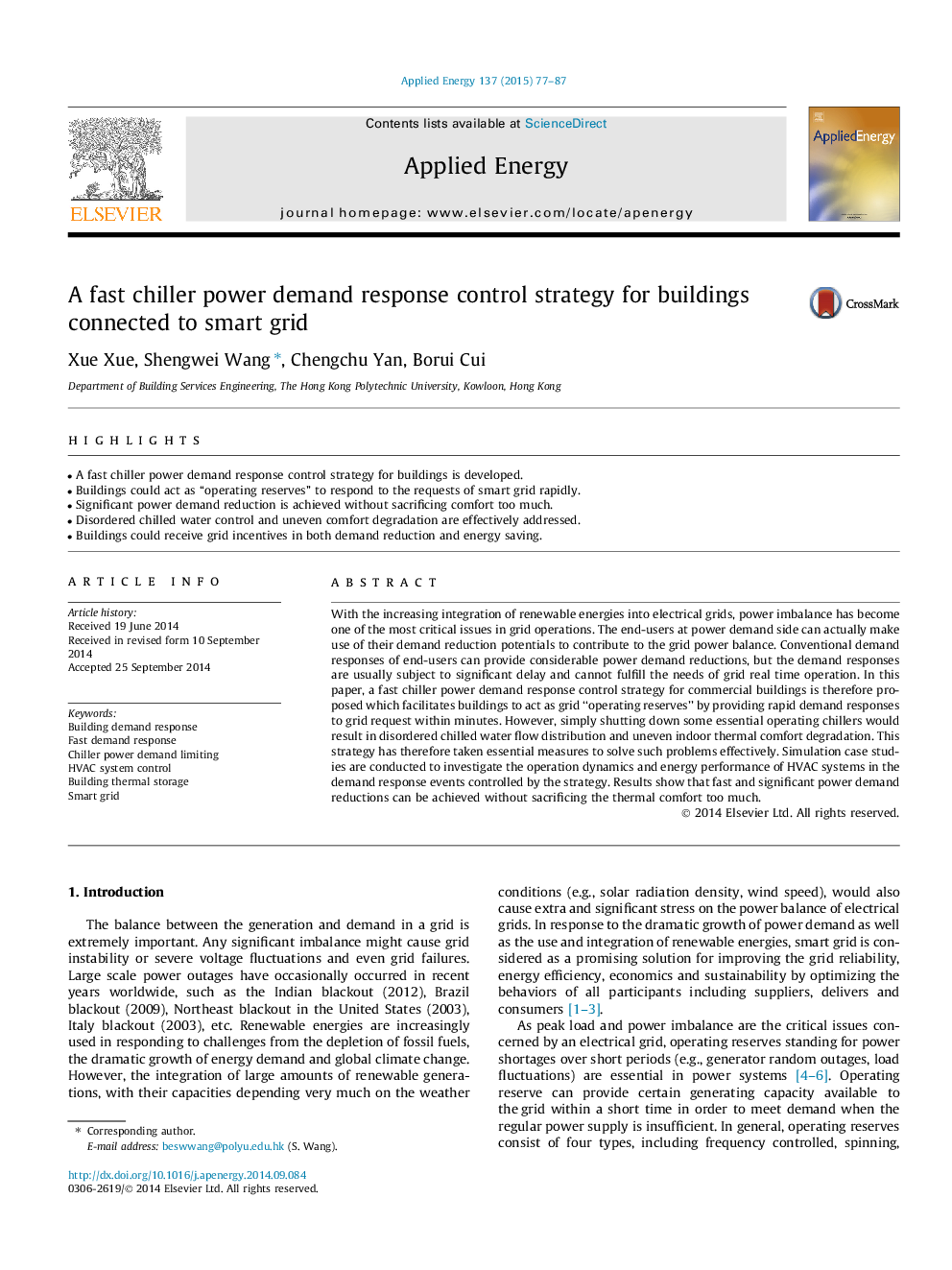| کد مقاله | کد نشریه | سال انتشار | مقاله انگلیسی | نسخه تمام متن |
|---|---|---|---|---|
| 6688373 | 501887 | 2015 | 11 صفحه PDF | دانلود رایگان |
عنوان انگلیسی مقاله ISI
A fast chiller power demand response control strategy for buildings connected to smart grid
ترجمه فارسی عنوان
استراتژی کنترل واکنش قدرت چیلر سریع برای ساختمان های متصل به شبکه هوشمند
دانلود مقاله + سفارش ترجمه
دانلود مقاله ISI انگلیسی
رایگان برای ایرانیان
ترجمه چکیده
با افزایش ادغام انرژی های تجدید پذیر در شبکه های برق، عدم تعادل قدرت یکی از مهم ترین مسائل در عملیات شبکه است. کاربران نهایی در سمت تقاضای انرژی می توانند از پتانسیل کاهش تقاضای خود برای کمک به توازن قدرت شبکه استفاده کنند. پاسخ های تقاضای تقاضای مصرف کنندگان نهایی می تواند کاهش تقاضای قابل توجهی را ارائه دهد اما پاسخ های تقاضا معمولا تاخیر قابل توجهی دارند و نمی توانند نیازهای عملیات زمان واقعی شبکه را تامین کنند. در این مقاله، یک استراتژی کنترل پاسخ کنترل تقاضای سریع خنک کننده برای ساختمان های تجاری پیشنهاد شده است که باعث می شود ساختمان ها به عنوان شبکه ذخیره سازی عمل کنند. با ارائه پاسخ سریع تقاضای تقاضای شبکه در عرض چند دقیقه. با این حال، به سادگی خاموش کردن برخی از چیلرهای عامل ضروری منجر خواهد شد توزیع جریان آب سرد سرد و تضعیف ناهموار گرما در محیط داخلی. بنابراین این استراتژی اقدامات ضروری برای حل این مشکلات را به طور موثر انجام داده است. مطالعات موردی شبیه سازی برای بررسی پویایی عملیات و عملکرد انرژی سیستم های تهویه مطبوع در حوادث پاسخگویی تقاضا تحت کنترل استراتژی انجام شده است. نتایج نشان می دهد که کاهش سریع تقاضای برق قابل توجهی می تواند بدون کاهش فزاینده حرارت ایجاد شود.
موضوعات مرتبط
مهندسی و علوم پایه
مهندسی انرژی
مهندسی انرژی و فناوری های برق
چکیده انگلیسی
With the increasing integration of renewable energies into electrical grids, power imbalance has become one of the most critical issues in grid operations. The end-users at power demand side can actually make use of their demand reduction potentials to contribute to the grid power balance. Conventional demand responses of end-users can provide considerable power demand reductions, but the demand responses are usually subject to significant delay and cannot fulfill the needs of grid real time operation. In this paper, a fast chiller power demand response control strategy for commercial buildings is therefore proposed which facilitates buildings to act as grid “operating reserves” by providing rapid demand responses to grid request within minutes. However, simply shutting down some essential operating chillers would result in disordered chilled water flow distribution and uneven indoor thermal comfort degradation. This strategy has therefore taken essential measures to solve such problems effectively. Simulation case studies are conducted to investigate the operation dynamics and energy performance of HVAC systems in the demand response events controlled by the strategy. Results show that fast and significant power demand reductions can be achieved without sacrificing the thermal comfort too much.
ناشر
Database: Elsevier - ScienceDirect (ساینس دایرکت)
Journal: Applied Energy - Volume 137, 1 January 2015, Pages 77-87
Journal: Applied Energy - Volume 137, 1 January 2015, Pages 77-87
نویسندگان
Xue Xue, Shengwei Wang, Chengchu Yan, Borui Cui,
